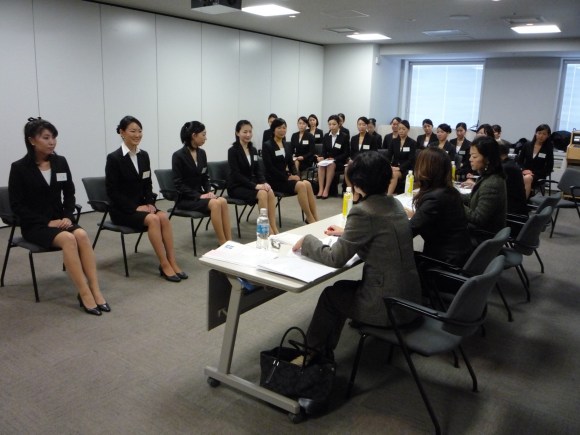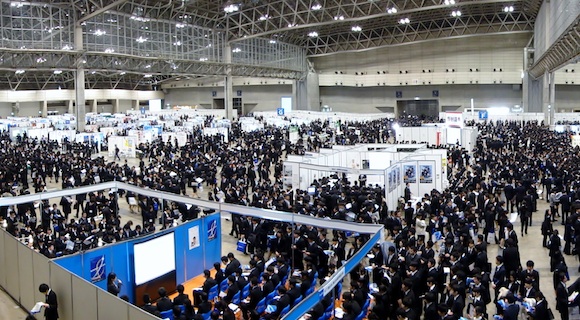
As far as things not to say in an interview go, you’d think it’d be pretty high up on the list. But the young Japanese university student, rejected by all the other companies he’d applied to, was prepared to take the risk. “This company is the only option I have left,” he pleaded with the interviewer. “I’ll do anything!” An unusual strategy, certainly. But he got the job.
Japanese site Niconico News reports that the man is now entering his ninth year of employment with the company, so it seems the gamble paid off. But is the company’s positive reaction so unusual? Some Japanese employability experts are arguing that, for many companies, the ideal graduate recruit is a “hakushi” – a blank page that the company can do what they want with. When companies train new recruits extensively, an across-the-board willingness to learn is valued more than previous experience.
The process of job hunting that the vast majority of Japanese university students take part in is known as “shūkatsu” (from “shūshoku katsudou” 就職活動). Unlike many other countries where students wait until their final year or after graduating to look for work, Japanese students take part in a rigidly-scheduled process which begins in their third year of university with a programme of internships, applications, and interviews. By the beginning or middle of fourth year, most students have already been hired for the job they will take up on April 1 the following year.
▼ A company information session for student job-hunters.
Students are under an enormous amount of pressure to succeed in entering a company. With companies preferring new graduates, those who fail to find work during the set shūkatsu period can find it increasingly difficult to be hired as a “previous graduate”. Finding a job out of university is no longer the guarantee of employment for life it once was, but this pressure to secure a position as soon as you graduate is the desperation that leads some students to feel that any job, any company, any field is fine, so long as it’s a job. Having a specialised area of interest, therefore, can actually be seen as inflexibility.
Yoku Date, a businessman and academic who writes on employability, says that compared to an applicant who talks about their experience and skills up to now in specific terms, one who simply shows a willingness to accept and learn the company’s way of doing things will provide the blank slate which employers are looking for. To succeed in job-hunting, he argues, students must draw a line under their university experience and be accommodating to the challenges of the world of work.
▼ Another unorthodox, and probably less effective, method.
But while some employers welcome the enthusiasm of those with an “I’ll do anything” attitude, others feel that it goes too far. Nobuhiro Kawaharasaki, CEO of web start-up logmi, blogged on June 15 that these kind of utterances show a lack of substance:
“When an applicant says ‘I’ll do anything!’ or ‘I’d give anything!’, just entering the company has become their only goal.”
Instead, he looks for a candidate who can work to take the company in new directions after they are hired. Their focus, he argues, should be one what they will do after they join the company, not only on the objective of finding a job. This approach is particularly relevent for startups, whose success will depend on innovation and intelligent risk-taking.
Of Japanese students who graduated this spring, 93.9 percent went straight into employment, taking up a position on April 1. That figure, however, doesn’t include students who went on to do master’s courses or who are repeating their final year (both common choices for students who haven’t received any job offers). When those students are factored in, the rate drops to 66 percent. The stress of the shūkatsu process, meanwhile, takes its toll on students, but the system doesn’t show any signs of changing any time soon.
Sources: Niconico News, Kawapara (Nobuhiro Kawaharasaki’s blog), Diamond Online
Featured image: Bullseye Recruiting
Top image: Think or Die Inset: Dick Johnson/Wikimedia (edited by RocketNews24)



 Japan’s hellish job hunting process “shuukatsu” gets animated, terrifies netizens 【Video】
Japan’s hellish job hunting process “shuukatsu” gets animated, terrifies netizens 【Video】 Japanese ministers call for reform of company hiring practices that focus on new graduates
Japanese ministers call for reform of company hiring practices that focus on new graduates Foreigners in Japan sound off on the top four quirks of the Japanese job-hunting system
Foreigners in Japan sound off on the top four quirks of the Japanese job-hunting system “Face Hiring”: Japanese cosmetics company Isehan’s new hiring campaign is causing a stir
“Face Hiring”: Japanese cosmetics company Isehan’s new hiring campaign is causing a stir Japanese new recruit fired after one month for being partially out of frame during video meetings
Japanese new recruit fired after one month for being partially out of frame during video meetings Japan’s EF English Proficiency Index rank drops for 11th straight year, hits lowest ever
Japan’s EF English Proficiency Index rank drops for 11th straight year, hits lowest ever Nintendo’s Kirby now delivering orders at Kura Sushi restaurants, but not in Japan
Nintendo’s Kirby now delivering orders at Kura Sushi restaurants, but not in Japan Foreign driver’s license conversion test passes plummet from over 90% to 33% in Japan
Foreign driver’s license conversion test passes plummet from over 90% to 33% in Japan Japan’s human washing machines will go on sale to general public, demos to be held in Tokyo
Japan’s human washing machines will go on sale to general public, demos to be held in Tokyo Starbucks Japan unveils new Christmas goods, drinkware and candles for the 2025 holiday season
Starbucks Japan unveils new Christmas goods, drinkware and candles for the 2025 holiday season Clever and cute cat keyhole bra is only one-fourth of lingerie set’s feline charms 【Photos】
Clever and cute cat keyhole bra is only one-fourth of lingerie set’s feline charms 【Photos】 Harvester Yakumo: A restaurant inspired by the Colonel from KFC
Harvester Yakumo: A restaurant inspired by the Colonel from KFC Nintendo releases Metroid-shaped ice cube/cooking tray and Samus arm cannon pillow【Pics】
Nintendo releases Metroid-shaped ice cube/cooking tray and Samus arm cannon pillow【Pics】 Godzilla-shaped ice cream on sale in Tokyo near the sight his most adorable rampage
Godzilla-shaped ice cream on sale in Tokyo near the sight his most adorable rampage Japan considering raising international traveler departure tax even more than previously reported
Japan considering raising international traveler departure tax even more than previously reported Japanese train company is letting fans buy its actual ticket gates for their homes
Japanese train company is letting fans buy its actual ticket gates for their homes Yoshinoya adds first-ever chain-wide ramen with new beef and pork-broth noodle hot pot meals
Yoshinoya adds first-ever chain-wide ramen with new beef and pork-broth noodle hot pot meals Is China’s don’t-go-to-Japan warning affecting tourist crowds in Shibuya’s Don Quijote?
Is China’s don’t-go-to-Japan warning affecting tourist crowds in Shibuya’s Don Quijote? Is China’s don’t-go-to-Japan warning affecting tourist crowd sizes in Nara?
Is China’s don’t-go-to-Japan warning affecting tourist crowd sizes in Nara? Studio Ghibli stamps lift your spirits with motivational phrases from Totoro
Studio Ghibli stamps lift your spirits with motivational phrases from Totoro New fish discovered and named “Vanderhorstia supersaiyan” for obvious reasons
New fish discovered and named “Vanderhorstia supersaiyan” for obvious reasons Japanese town suing resident for being a jerk
Japanese town suing resident for being a jerk Starbucks Japan unveils new Christmas goods and a rhinestone tumbler that costs 19,500 yen
Starbucks Japan unveils new Christmas goods and a rhinestone tumbler that costs 19,500 yen Real-world Nausicaa Ghibli anime glider completes its final flight in Japan【Video】
Real-world Nausicaa Ghibli anime glider completes its final flight in Japan【Video】 Brand-new Pokémon park opens in Japan with larger-than-life-size Lapras【Photos】
Brand-new Pokémon park opens in Japan with larger-than-life-size Lapras【Photos】 Unique inclined elevator in Japan leads to a town that inspired Studio Ghibli’s Spirited Away
Unique inclined elevator in Japan leads to a town that inspired Studio Ghibli’s Spirited Away Is China’s don’t-go-to-Japan warning affecting tourist crowds in Tokyo’s Asakusa neighborhood?
Is China’s don’t-go-to-Japan warning affecting tourist crowds in Tokyo’s Asakusa neighborhood? The 10 best day trips from downtown Tokyo【Survey】
The 10 best day trips from downtown Tokyo【Survey】 Naturally brown-haired Osaka student sues government for forcing her to dye her hair black
Naturally brown-haired Osaka student sues government for forcing her to dye her hair black Tokyo hotel lets you make your stay a Sanrio one with special My Melody and Kuromi rooms【Pics】
Tokyo hotel lets you make your stay a Sanrio one with special My Melody and Kuromi rooms【Pics】 Survey asks foreign tourists what bothered them in Japan, more than half gave same answer
Survey asks foreign tourists what bothered them in Japan, more than half gave same answer Japan’s deadliest food claims more victims, but why do people keep eating it for New Year’s?
Japan’s deadliest food claims more victims, but why do people keep eating it for New Year’s? We deeply regret going into this tunnel on our walk in the mountains of Japan
We deeply regret going into this tunnel on our walk in the mountains of Japan Studio Ghibli releases Kodama forest spirits from Princess Mononoke to light up your home
Studio Ghibli releases Kodama forest spirits from Princess Mononoke to light up your home Major Japanese hotel chain says reservations via overseas booking sites may not be valid
Major Japanese hotel chain says reservations via overseas booking sites may not be valid Put sesame oil in your coffee? Japanese maker says it’s the best way to start your day【Taste test】
Put sesame oil in your coffee? Japanese maker says it’s the best way to start your day【Taste test】 The top 10 annoying foreign tourist behaviors on trains, as chosen by Japanese people【Survey】
The top 10 annoying foreign tourist behaviors on trains, as chosen by Japanese people【Survey】 No more using real katana for tourism activities, Japan’s National Police Agency says
No more using real katana for tourism activities, Japan’s National Police Agency says J-pop mega star Ado reveals she’s been living in the U.S., may not understand language acquisition
J-pop mega star Ado reveals she’s been living in the U.S., may not understand language acquisition Japanese clothing chain offers an answer to job-hunting suit conundrum
Japanese clothing chain offers an answer to job-hunting suit conundrum To handwrite, or not to handwrite? Recruiter lays into ‘laziness’ of young Japanese job hunters
To handwrite, or not to handwrite? Recruiter lays into ‘laziness’ of young Japanese job hunters Japanese businesses anger universities by offering jobs to their students
Japanese businesses anger universities by offering jobs to their students Report on lousy schools in Japan spurs debate on who’s to blame
Report on lousy schools in Japan spurs debate on who’s to blame Pokémon game developer Game Freak is now hiring, holding online interviews for new jobs
Pokémon game developer Game Freak is now hiring, holding online interviews for new jobs Pantene ad asks why people in Japan are forced to look the same when job hunting
Pantene ad asks why people in Japan are forced to look the same when job hunting The number of doctorate students in Japan is now almost half of what it was 17 years ago
The number of doctorate students in Japan is now almost half of what it was 17 years ago Soba restaurant in Japan struggles to find new employee, rewords job ad and offers flood in
Soba restaurant in Japan struggles to find new employee, rewords job ad and offers flood in It’s all about the money: The best (and worst) paid student jobs in Japan
It’s all about the money: The best (and worst) paid student jobs in Japan 5 discriminatory interview questions employers in Japan are no longer allowed to ask
5 discriminatory interview questions employers in Japan are no longer allowed to ask Japanese job-hunters reportedly dismayed by requests for “photos showing who you are as a person”
Japanese job-hunters reportedly dismayed by requests for “photos showing who you are as a person” Japanese university students reveal the part-time jobs they’d most like to have
Japanese university students reveal the part-time jobs they’d most like to have Free highway bus for students connects Tokyo and Fukushima for business or pleasure
Free highway bus for students connects Tokyo and Fukushima for business or pleasure Tokyo University of the Arts to offer graduate program in video game design next year
Tokyo University of the Arts to offer graduate program in video game design next year
Leave a Reply